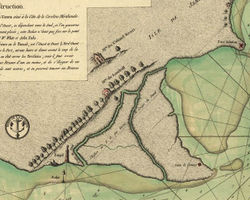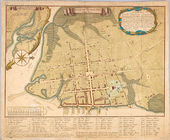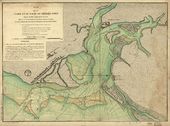Elizabeth Pitts Lamboll and Thomas Lamboll
Overview
Alternate names: Elizabeth Pitts Lamboll, Thomas Lamboll
Used Keywords: Bed, Flower garden, Kitchen garden, Prospect, Seat, Walk
Elizabeth Pitts Lamboll (1725–October 11, 1770)[1] and Thomas Lamboll (August 1694–October 29, 1774) developed one of the earliest botanic gardens in Charleston, South Carolina. They exchanged seeds, plants, and information with botanists and gardeners in America and Europe.
History
Following a series of fiery sermons preached in her native Boston by the English evangelist George Whitefield (1714–1770), fourteen-year-old Elizabeth Pitts journeyed to Savannah, Georgia, and entered Whitefield’s Bethesda Orphan House on December 13, 1740.[2] She was one of a handful of girls who were not orphans, but merely “poor,” with one or more parent still living.[3] At the Bethesda Orphan House, she received instruction in religion, Latin, arithmetic, writing, and reading. She also learned household skills intended to make her “serviceable,” such as sewing, spinning, and “housewifery.”[4] The seeds of her later fascination with gardening may have been planted at Bethesda. According to the English writer Edward Kimber (1719–1769), who visited the Bethesda Orphan House in 1743, the girls’ “vacant Hours were employ’d in Garden and Plantation-Work.” Kimber described the garden as “a very extensive one, and well kept up, . . . one of the best I ever saw in America.”[5]
After leaving the orphanage in June 1742, Elizabeth probably went into service in Charleston.[6] There, on November 29, 1744, she married Thomas Lamboll, a wealthy, well-educated merchant whose second wife had died the previous year.[7] Lamboll was a prominent public figure, having served for many years as justice of the peace and clerk of the Congregational Church.[8] He also owned extensive property in and around Charleston, including a rice plantation across the Ashley River on James Island, acquired by his father in 1696.[9] A French map of 1776 represents avenues of trees leading to a two-story house on the property [Fig. 1].

Around the time of Lamboll’s first marriage in 1737 to Margaret Edgar (1711–1742), he had commissioned the architect Thomas Lee (1710–1769) to build a house in Charleston on property he owned at the southernmost point of the city, bounded on the west by the Ashley River and on the east by the Cooper River [Fig. 2].[10] Lamboll may have laid out gardens as well, for he began importing plants, such as the Pride of India, or Chinaberry (melia azedarach), which he is credited with introducing to North America.[11] By the early 1740s he was corresponding with the English merchant Peter Collinson, to whom he sent Carolina plants in exchange for exotic specimens imported from Europe.[12] Reflecting on the many additions to his garden that came through Lamboll, Collinson observed in a letter of 1764 to Cadwallader Colden, “How Fragrant that Allspice, how Charming the Red flowered Acacia, Great Laurel Leafed Magnolia & Umbrella Magnolia & Loblolly Bay—these Charming Trees are the Glory of my Garden & the Trofies of that Friendship that subsists between Mee & my very obligeing Friend T. Lambol Esq of South Carolina.”[13]
Elizabeth Lamboll shared her husband’s interest in horticulture and botany. According to the historian and botanist David Ramsay, she developed a kitchen garden as well as a botanic garden within a few years of her marriage. He recalled her as the first of those “persons who cultivated gardens on a large scale both for use and pleasure,” adding “Before the middle of the 18th century, [she] improved the south west extremity of King-street, in a garden which was richly stored with flowers and other curiosities of nature in addition to all the common vegetables for family use.”[14] The garden extended directly south from the Lambolls’ house to the water’s edge.[15] The Lambolls also reportedly created a large rose garden on White Point, a narrow strip of land separated by marshes from their mainland Charleston property and accessible only by boat.
The Lambolls initiated a lengthy correspondence with John Bartram following his visit to Charleston in 1760. Elizabeth prepared and packed seeds, bulbs, and plants to send him from her garden, and Thomas conveyed her instructions, requests, and information in letters and lists. The “noble cargoes” sent from the Lambolls’ garden contained a treasure trove of exotic specimens, including pancratium amaryllis, belladonna lilies, umbrella trees.[16] After describing some of the Lambolls’ recent offerings in a letter to Collinson, Bartram exclaimed, “Oh Carolina Carolina A ravishing place for a curious Botanist.”[17] The Lambolls sent seeds and plants to a few gardeners other than Bartram (such as James Alexander at Springettsbury in Philadelphia), and in May 1765 Collinson even broached the idea that “by the aid of our Friend Lamboll seeds & specimens may be sent directly to Mee for the King.”[18] Bartram did not actually meet Elizabeth Lamboll until his second visit to Charleston in 1765, en route to Florida, when the two of them “rambled in the Intense Heat of a Mid Day sun.”[19] When Thomas Lamboll lagged in sending some coveted berries from a shrub that grew on James Island, Collinson urged Bartram to ask Elizabeth for them instead, for “the Women Deny the[e] Nothing[;] thou hath such a[n] Art of wriggling into their Good Graces to Drag specimens in Flower & then in Fruit.”[20]
—Robyn Asleson
Texts
- Lamboll, Thomas, February 16, 1761, describing his wife’s gardening methods to John Bartram (Bartram 1992: 504–5)[21]
- “The manner Mrs. Lamboll managers her Ranunculas & Anemonies every Year, is thus: She prepares Beds of good Rich Mould at least Two Months before she takes up the Flower Roots; that the Earth may be well settled by Rain. Wherever the Ground is low, she raised the Flower Beds, at least a foot in heighth, and where high flattens them. In Summer time, the leaves of the Flower Roots being thoroughly dry, immediately after a Shower of Rain happens, she takes up the said Roots, divides & cleanses them (but not by washing) from Insects, then makes slight holes with the Fingers on the Tops of the prepared Beds, places the Roots about four inches asunder and covers them over with Dirt, Scrap’d from the Paths, about half an Inch deep; strewing it over with the Fingers. And if the Rain fails she afterwards causes the Beds of Flower Roots to be Watered gently, such Water having first stood a Convenient time in the Sun. In Cold Weather she causes the Flower Beds to be Cover’d and Shelter’d; especially when they have begun to Sprout.”
- Bartram, John, July 11, 1765, diary entry while traveling through South Carolina (1942: 14)[22]
- “I have Just been on James island with Thomas Lambol & his lady to his countrey seat oposit to Charlstown. . .This day I spent in writeing letters & observing ye fine improvements of ye town & ye adjacent countrey seats.”
- Bartram, John, August 15, 1765, diary entry while traveling through South Carolina (1942: 19)[22] Bartram and Harper, 1942. view on Zotero.
- “We observed many good farms & gentlemens seats. . . Landed at Charlstown. . . & walked to our friend Lambols where we was accommodated in ye most civil & best manner. in A large chamber. one side fronting ye street with a large window & balcony with A prospect down ye bay [;] ye south side fronting ye garden & orange walks over which A lovely prospect apeared of James island over Ashley river[,] two mile broad[,] from two large windows[.] ye farther end of his garden reaches to within A few yards of ye rivers bank; ye north front hath A fine prospect of ye town through two large windows.”
- Shecut, John Linnaeus Edward Whitridge, 1819, describing the city of Charleston (1819: 42)[23]
- “Sometime about the year 1750, Mrs. Lamboll excited great interest in the science of horticulture and gardening, by planting a large and handsome flower and kitchen garden, upon the European plan. It was the first of the kind in Charleston, and occupied the site, corner of King and Lamboll-streets.”
Images
Other Resources
The Ichnography of Charles-Town at High Water (1739) interactive map, John Carter Brown Library
Notes
- ↑ For her death date, see “Records Kept by Colonel Isaac Hayne,” South Carolina Historical and Genealogical Magazine, 10 (July 1909): 159, view on Zotero.
- ↑ George White, Historical Collections of Georgia: Containing the Most Interesting Facts, Traditions, Biographical Sketches, Anecdotes, Etc. (New York: Pudney & Russell, 1854), 335, view on Zotero.
- ↑ White 1854, 335, view on Zotero. Significantly, Whitefield’s Boston sermon of October 8, 1740, had instructed children, “If your parents will not come to Christ, you [should] come and go to heaven without them.” See Thomas S. Kidd, George Whitefield: America’s Spiritual Founding Father (New Haven: Yale University Press, 2014), 126, view on Zotero. For the letter Elizabeth wrote to Whitefield describing herself as “the worst, the ungratefullest of all Sinners upon Earth,” see Sarah Gober Temple and Kenneth L. Coleman, Georgia Journeys: Being an Account of the Lives of Georgia’s Original Settlers and Many Other Early Settlers (Athens: University of Georgia Press, 2010), 233, view on Zotero.
- ↑ George Whitefield, “An Account of the Money Received and Disbursed for the Orphan House in Georgia” (December 23, 1740) in Eric McCoy North, Early Methodist Philanthropy (New York: The author, 1914), 157, view on Zotero; Lilla Mills Hawes, “A Description of Whitefield’s Bethesda: Samuel Fayrweather to Thomas Prince and Thomas Foxcroft,” Georgia Historical Quarterly 45 (December 1961): 366, view on Zotero; George Whitefield, The Works of the Reverend George Whitefield, M.A., . . . to Which Is Prefixed, an Account of His Life, Compiled from His Original Papers and Letters, 6 vols. (London: Edward and Charles Dilly, 1771), 3:466, view on Zotero. See also Kidd 2014, 118, 141, view on Zotero.
- ↑ The “Plantation-Work” evidently included picking cotton. See Edward Kimber, Itinerant Observations in America, ed. Kevin J. Hayes (Newark: University of Delaware Press, 1998), 34, view on Zotero.
- ↑ She is presumably the child Whitefield referenced in his “Continuation of the Account and Progress, &c. of the Orphan-House” (March 21, 1746): “One that I brought from New-England is handsomely settled in Carolina”; see Whitefield, 1771, 3:466, view on Zotero. She left Bethesda prior to the evacuation of the orphan home on July 10, 1742, when the children took refuge at the Charleston plantations of Jonathan Bryan (1708–1788), his brother Hugh (1699–1753), and their brother-in-law Stephen Bull (d.1770). See Whitefield, 1771, 3:455–59, view on Zotero; Alan Gallay, The Formation of a Planter Elite: Jonathan Bryan and the Southern Colonial Frontier (Athens: University of Georgia Press, 2007), 41, view on Zotero.
- ↑ Lamboll had married Mary Detmar (1710–September 15, 1743) on September 21, 1742. At the time of his marriage to Elizabeth Pitts, he had a three-year-old son by his first wife. See Alexander Samuel Salley Jr., Register of St. Philip’s Parish Charles Town, South Carolina, 1720–1758 (Charleston: Walker, Evans & Cogswell, 1904), 94, 177, 180, view on Zotero; Mabel L. Webber, “Inscriptions from the Independent or Congregational (Circular) Church Yard Charleston, S.C. (Continued),” South Carolina Historical and Genealogical Magazine 29 (April 1928): 143, view on Zotero.
- ↑ Walter B. Edgar and N. Louise Bailey, Biographical Directory of the South Carolina House of Representatives, 5 vols. (Columbia: University of South Carolina Press, 1977), 387–88, view on Zotero; Elise Pinckney, Thomas and Elizabeth Lamboll: Early Charleston Gardeners, Charleston Museum Leaflet, No. 28 (Charleston, SC: Charleston Museum, 1969), 4–9, view on Zotero.
- ↑ John Bartram and Francis Harper, “Diary of a Journey through the Carolinas, Georgia, and Florida from July 1, 1765, to April 10, 1766,” Transactions of the American Philosophical Society 33 (December 1942): 57, view on Zotero; Pinckney 1969, 4, 6–7, view on Zotero; Preservation Consultants, Inc., James Island and Johns Island Historical Survey (Charleston: South Carolina Department of Archives and History, Summer 1989), 8, view on Zotero.
- ↑ The house is extant at 19 King Street in Charleston (Pinckney 1969, 6–7, view on Zotero).
- ↑ David Ramsay, The History of South-Carolina: From Its First Settlement in 1670, to the Year 1808, 2 vols. (Charleston: David Longworth, 1809), 2:346, view on Zotero.
- ↑ For Collinson’s letter of May 1762 to John Bartram in which he notes, “It may be 20 years agon since I gave the White Broom to our Frd Lamboll which was sent me from Portugal,” and Collinson’s letter of July 25, 1762, describing a plant Lamboll sent to him “many years agon,” see John Bartram, The Correspondence of John Bartram, 1734–1777, ed. Edmund Berkeley and Dorothy Smith Berkeley (Gainsville: University Press of Florida, 1992), 561, 566, view on Zotero.
- ↑ Peter Collinson to Cadwallader Colden, February 25, 1767, in “Forget Not Mee & My Garden”: Selected Letters 1725–1768 of Peter Collinson, F.R.S., ed. Alan W. Armstrong (Philadelphia: American Philosophical Society, 2002), 257, view on Zotero.
- ↑ Ramsay 1809, 2:227, view on Zotero.
- ↑ Pinckney, 1969, 25, view on Zotero.
- ↑ Quotation is from Bartram to Collinson, May 10, 1762, in Bartram 1992, 559; see also 504–5, 511, 549, 575, 614, 620, 637–38, 648, view on Zotero.
- ↑ John Bartram to Peter Collinson, May 10, 1762, in Bartram 1992, 558, view on Zotero.
- ↑ Peter Collinson to John Bartram, April 9, 1765, in Bartram 1992, 644; see also 505, 634–35, 676–77,view on Zotero.
- ↑ Peter Collinson to John Bartram, September 19, 1765, in Bartram 1992, 654; see also 656, view on Zotero.
- ↑ Peter Collinson to John Bartram, December 25, 1767, Bartram 1992, 695; see also 686, 688, 694, view on Zotero.
- ↑ Bartram 1992, view on Zotero.
- ↑ 22.0 22.1 Bartram and Harper 1942.
- ↑ John Linnaeus Edward Whitridge Shecut, Shecut’s Medical and Philosophical Essays . . . The Whole of Which Are Designed as Illustrative of the Domestic Origin of the Yellow Fever of Charleston; And, as Conducing to the Formation of a Medical History of the State of South-Carolina (Charleston: A. E. Miller, 1819), view on Zotero.


